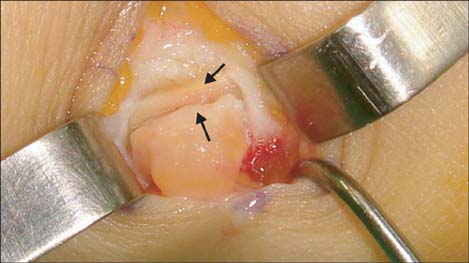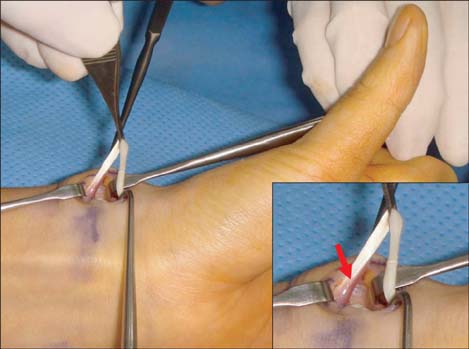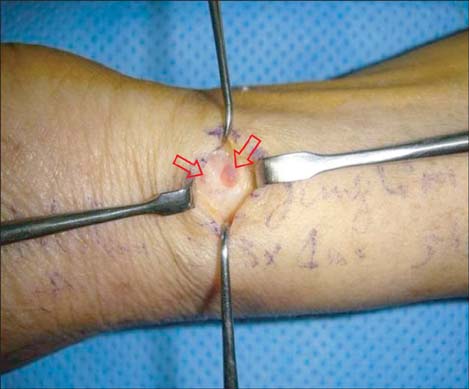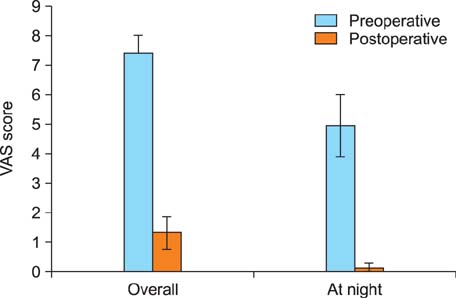Clin Orthop Surg.
2014 Dec;6(4):405-409. 10.4055/cios.2014.6.4.405.
Surgical Release of the First Extensor Compartment for Refractory de Quervain's Tenosynovitis: Surgical Findings and Functional Evaluation Using DASH Scores
- Affiliations
-
- 1Department of Orthopaedic Surgery, Kyungpook National University Hospital, Kyungpook National University School of Medicine, Daegu, Korea.
- 2Department of Orthopaedic Surgery, Daegu Park Hospital, Daegu, Korea.
- 3Department of Orthopaedic Surgery, Fatmawati National General Hospital, Jarkarta, Indonesia.
- 4Department of Orthopedic Surgery, Asan Medical Center, University of Ulsan College of Medicine, Seoul, Korea. jeonchoi@gmail.com
- KMID: 1794728
- DOI: http://doi.org/10.4055/cios.2014.6.4.405
Abstract
- BACKGROUND
Few studies have evaluated surgical outcomes in patients with refractory de Quervain's disease using validated outcome measures. We assessed the clinical outcomes of dorsal release of the first extensor compartment for the treatment of de Quervain's disease using the disabilities of the arm, shoulder and hand (DASH) score.
METHODS
From October 2003 to May 2009, we retrospectively evaluated 33 patients (3 men and 30 women) who underwent surgical treatment for de Quervain's disease. All patients had a positive Finkelstein test and localized tenderness over the first dorsal compartment. All operations were performed under local anesthesia. A 2-cm-long transverse skin incision was made over the first extensor compartment and the dorsal retinaculum covering the extensor pollicis brevis was incised longitudinally. Preoperative and postoperative clinical evaluation included the use of DASH score, Finkelstein test, and visual analogue scale (VAS) score.
RESULTS
In 18 patients (55%), the extensor pollicis brevis tendon compartment was separated from the abductor pollicis longus compartment. Eight patients had intracompartmental ganglia in the extensor pollicis brevis subcompartment. All patients except one had negative sign on Finkelstein test at the last follow-up. The average VAS score decreased from 7.42 preoperatively to 1.33 postoperatively (p < 0.05), and DASH score was improved from 53.2 to 3.45 (p < 0.05). There were no postoperative complications such as subluxation of the tendon of the first dorsal compartment or injury to the sensory branch of the radial nerve.
CONCLUSIONS
Intracompartment ganglia and the separate septum of extensor pollicis brevis are often related to de Quervain's disease. The release of the first extensor compartment for refractory de Quervain's disease resulted in good clinical outcomes with minimal morbidity.
MeSH Terms
Figure
Reference
-
1. Clarke MT, Lyall HA, Grant JW, Matthewson MH. The histopathology of de Quervain's disease. J Hand Surg Br. 1998; 23(6):732–734.2. de Quervain F. On a form of chronic tendovaginitis. (Translated article: Cor-Bl.f.schweiz. Aerzrte 1895:25:389-94). J Hand Surg Br. 2005; 30(4):388–391.3. Kay NR. De Quervain's disease. Changing pathology or changing perception? J Hand Surg Br. 2000; 25(1):65–69.4. Green DP, Hotchkiss RN, Pederson WC, Wolfe SW, editors. Green's operative hand surgery. 5th ed. New York: Elsevier, Churchill-Livingstone;2005.5. Sawaizumi T, Nanno M, Ito H. De Quervain's disease: efficacy of intra-sheath triamcinolone injection. Int Orthop. 2007; 31(2):265–268.6. Zingas C, Failla JM, Van Holsbeeck M. Injection accuracy and clinical relief of de Quervain's tendinitis. J Hand Surg Am. 1998; 23(1):89–96.7. McKenzie JM. Conservative treatment of de Quervain's disease. Br Med J. 1972; 4(5841):659–660.8. Witt J, Pess G, Gelberman RH. Treatment of de Quervain tenosynovitis: a prospective study of the results of injection of steroids and immobilization in a splint. J Bone Joint Surg Am. 1991; 73(2):219–222.9. Capasso G, Testa V, Maffulli N, Turco G, Piluso G. Surgical release of de Quervain's stenosing tenosynovitis postpartum: can it wait? Int Orthop. 2002; 26(1):23–25.10. Hudak PL, Amadio PC, Bombardier C. Development of an upper extremity outcome measure: the DASH (disabilities of the arm, shoulder and hand). The Upper Extremity Collaborative Group (UECG). Am J Ind Med. 1996; 29(6):602–608.11. White GM, Weiland AJ. Symptomatic palmar tendon subluxation after surgical release for de Quervain's disease: a case report. J Hand Surg Am. 1984; 9(5):704–706.12. Littler JW, Freedman DM, Malerich MM. Compartment reconstruction for De Quervain's disease. J Hand Surg Br. 2002; 27(3):242–244.13. Yuasa K, Kiyoshige Y. Limited surgical treatment of de Quervain's disease: decompression of only the extensor pollicis brevis subcompartment. J Hand Surg Am. 1998; 23(5):840–843.14. Maruyama M, Takahara M, Kikuchi N, Ito K, Watanabe T, Ogino T. De Quervain disease caused by abductor pollicis longus tenosynovitis: a report of three cases. Hand Surg. 2009; 14(1):43–47.15. Scheller A, Schuh R, Honle W, Schuh A. Long-term results of surgical release of de Quervain's stenosing tenosynovitis. Int Orthop. 2009; 33(5):1301–1303.16. Jester A, Harth A, Wind G, Germann G, Sauerbier M. Disabilities of the arm, shoulder and hand (DASH) questionnaire: Determining functional activity profiles in patients with upper extremity disorders. J Hand Surg Br. 2005; 30(1):23–28.17. Tan MY, Low CK, Tan SK. De Quervain's tenosynovitis and ganglion over first dorsal extensor retinacular compartment. Ann Acad Med Singapore. 1994; 23(6):885–886.
- Full Text Links
- Actions
-
Cited
- CITED
-
- Close
- Share
- Similar articles
-
- De Quervain's Disease Associated with Osseous Septum: A Case Report
- First extensor compartment morphology and clinical significance: a cadaver series study
- Relationship to the superficial radial nerve and anatomic variations of the first extensor compartment in Thai population: a basis for successful de Quervain tenosynovitis treatment
- Septated de Quervain's Disease with MRI Images: A case report
- Comparative Analysis of Ultrasound and Surgical Findings in Anatomical Variations of de Quervain’s Disease






